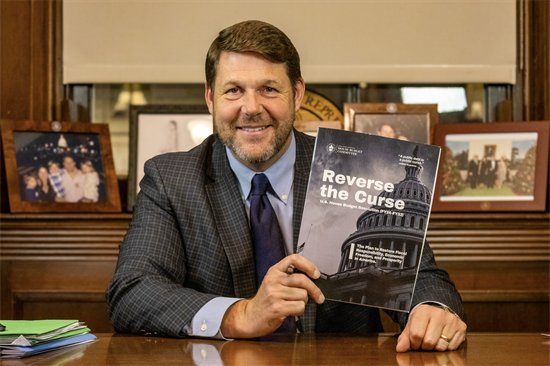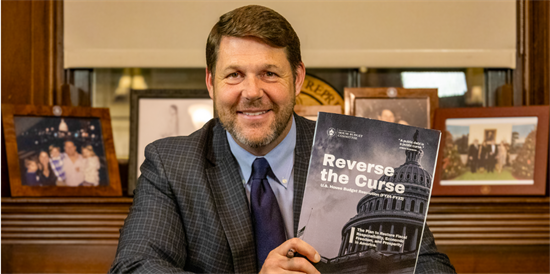Believe it or not, the House Budget Committee is getting things done
By Kevin Kosar
Sept. 20, 2024
AS SEEN IN THE WASHINGTON EXAMINER
The average person would be forgiven for thinking Congress is completely bungling budgeting. The national debt is on a path to soar to $37 trillion by the end of the year. Legislators have failed to enact the 12 government spending bills. They have spent September feuding over whether to enact a continuing resolution to keep money flowing and avoid a partial or complete government shutdown on Oct. 1.
Yet amid all the bad news, there are shoots of green. The House Budget Committee is doing its job. It recognizes the nation’s fiscal troubles and is goading the rest of Congress to cut government bloat and staunch the flow of red ink.
This spring, the committee approved a budget resolution to set total spending levels for the government. This effort was notable not least because it was the first time in the past five years that the committee had passed a budget on time.
The 167-page document aims to eliminate the annual deficit over a 10-year period. It would slow the cost growth of many spending programs and outright repeal others, such as President Joe Biden’s student loan forgiveness. Other savings would be achieved through reducing the improper payments or the instances when the government sends money to individuals or organizations who do not qualify.
No new taxes are included in the resolution. Instead, it hopes to increase the flow of dollars to the Treasury by directing Congress to enact “pro-growth” policies, such as cutting regulations and sporting the expansion of U.S. energy production. Chairman Jodey Arrington (R-TX) defended the trillions of dollars in proposed cuts: “Ladies and gentlemen, the facts are irrefutable. Our deficit spending is out of control, our national debts are unsustainable, and the fiscal state of the Union is in rapid decline.”

Chairman Jodey Arrington (TX-19) |
|
Democrats on the Budget Committee heaped scorn on the resolution and faulted its economic assumptions.
“The budget uses astonishing predictions of economic growth, tax receipts, and future spending levels. The economic assumptions behind the budget appear to be a wild departure from all reputable sources.” None of them voted for the resolution, and the Democratic-controlled Senate has not taken up the resolution or produced one of its own, leaving it a dead letter.
Undeterred, Arrington and the committee have kept their shoulders to the wheel. The committee has drafted some ideas for improving the broken 50-year-old budget process, and it has asked for feedback and additional ideas from groups and individuals outside Congress. It also has approved 10 bills to alter aspects of the congressional budgeting.
“My goal from the outset was to make the budget committee great again by reining-in spending, fixing the broken budget process, and restoring fiscal sanity in Washington,” Arrington said in an email shared by a committee staffer. Arrington added the committee had made “tremendous strides” toward these goals and noted that he and panel members “help[ed] lead the debt ceiling negotiations, which yielded the biggest discretionary spending cuts in 10 years.”
While budgetary issues often devolve into partisan posturing, the House Budget Committee has moved legislation with the support of both sides of the aisle. Arrington co-sponsored ranking member Brendan Boyle’s (D-PA) measure to force executive agencies to share more spending data with the Congressional Budget Office. Committee Republicans and Democrats alike voted to establish a fiscal commission to get the nation’s finances in order and to have the Senate and House annually convene and listen to a fiscal “state of the union” presentation by the nonpartisan comptroller general.
Committee Republicans and Democrats also have supported measures to require the president to include in his budget a debt-to-gross domestic product ratio and to add a per capita federal debt figure to each taxpayer’s W-2 form. (That number was about $229,546.702, or $35,256,056,842,790.06 divided by 153,589,908, at the time of writing.)
Unfortunately, only two of the bills have won a vote in the House: Boyle and Arrington’s legislation and a measure to curb the long-term growth in healthcare spending by encouraging more preventive care policies. The Senate passed the CBO legislation, and it may soon land on the president’s desk.
Quite possibly, the House will move more of these bills this autumn. But whether any of them get through the Senate is hard to say. The “world’s greatest deliberative body” has shown few signs that it is grappling with the federal budget mess.
Its Budget Committee did not approve a budget resolution despite the law requiring it to do so by April. Much of its work has been devoted to expanding consumer uptake of electric vehicles, climate change, reproductive freedom, and increasing taxes on corporations. And while the House passed five of the 12 spending bills, the Senate has passed none.




